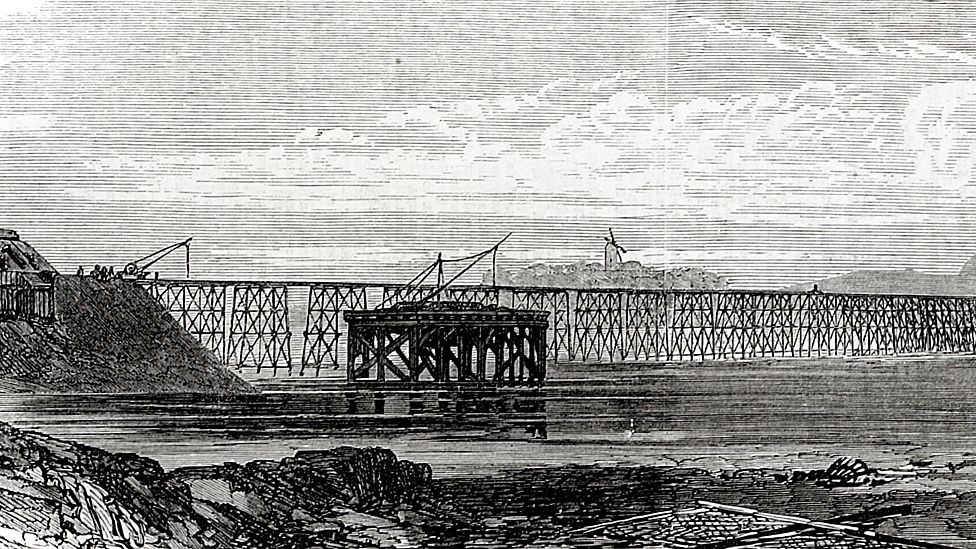Solway Junction Railway: The ill-fated Scotland to England rail route
- Published

Staring out across the Solway Firth it is easy to see how the temptation arose.
Instead of taking a detour via Carlisle, why not cut the corner and make a more direct link between the iron ore mines of Cumberland and the furnaces of Lanarkshire?
That was the idea behind the Solway Junction Railway which opened 150 years ago on 13 September 1869.
The only obstacle - the stretch of water between Scotland and England - would be overcome by a viaduct about 2,000 yards (1.8km) long.
The first sod was cut at Annan in March 1865 and work began on building the iron structure, averaging about 34ft (10m) from rails to the bed of the Solway Firth.
A ballad was even written for the occasion.
Its chorus went: "Come, come! stout men of Annandale/Bear yourselves nobly; keep in good order./Cheer, cheer! loud let your welcome be/Welcome the strangers from over the Border."
It would take more than four years - and an accident which claimed one man's life - before the line was complete.
It opened for goods and mineral traffic on Monday 13 September 1869 "without any ceremony" and to passengers nearly a year later.
The northern section joined the Caledonian Railway line at Kirtlebridge while the southern section joined up with the North British Silloth to Carlisle line.
Initially it proved a success - for both freight and the public - but the tide turned pretty quickly.
"At first the line was profitable with the ore trains for Lanarkshire passing over the line," wrote Stuart Edgar and John M Sinton in their book The Solway Junction Railway.
"But in the mid-1870s the ore traffic began to decline due to the cheaper imports of Spanish ore and the Solway Junction Railway increasingly experienced financial difficulties as its capital was swallowed up."
Within six years of opening the first weather troubles struck too with some pillars cracked by frost.
It would be damaged by frost and gales on dozens of occasions - one of the worst in January 1881.
Large blocks of ice hit the viaduct with the sound described as like "artillery fire" and making the whole structure vibrate.
Money was raised to repair and strengthen the viaduct but it would not fully reopen until 1884.
It was the beginning of a slow decline which was only temporary reversed during World War One with demand for munitions - but complete closure was not far away.
In August 1921 - facing a repairs bill estimated at £70,000 at the time - the last train crossed the viaduct.
"The closure of the viaduct to rail traffic in 1921, however, did not mean the end of its use as many a Scottish Border Romeo slipped secretly across the Solway viaduct to keep a rendezvous with his fair English Juliet," said the book about the railway.
"Furthermore many Scots denied licensed hospitality in those days on the Sabbath would daringly get around the laws by walking across the viaduct, their aim being to enjoy the jovial thirst-quenching atmosphere of an English Inn.
"Even after the viaduct was declared dangerous, these 'excursions' continued along the line on which no trains ran."
Dismantling began in 1934 with three young men losing their lives during the demolition works the following year.
Usage of the remaining line which had linked the viaduct to the main network also dwindled and it too was closed.
Nowadays, only a few hints remain of where the ill-fated line once was - it had flourished briefly before the hard rules of business and the British weather took their toll.